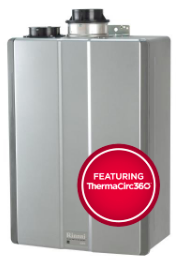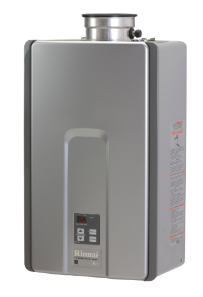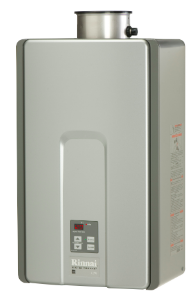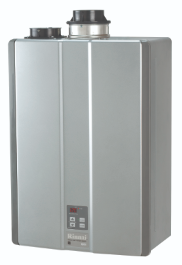
Rinnai is a leading manufacturer of tankless water heaters. All the heaters are at least high efficiency and suitable for the whole house, but they are still compact.
Many are also Energy Star qualified and use the latest technology available — for instance, they are WiFi enabled and controllable through voice command. These qualities have helped Rinnai become the single best-selling water heater company in all of North America.
Table of Contents
Top 5 Rinnai Tankless Water Heaters
| IMAGE | PRODUCT | FEATURES | ||
|---|---|---|---|---|
Best of Best  | Best of Best | RUR98 |
| CHECK PRICE |
 | RUC98 |
| CHECK PRICE | |
 | RLX94 |
| CHECK PRICE | |
 | RL75 |
| CHECK PRICE | |
Best for Money  | Best for Money | V75 |
| CHECK PRICE |
About Rinnai

Rinnai was founded in 1920 by Hidejiro Naito and Kanekichi Hayashi. The company started out manufacturing cooking stoves in Japan. In the 1930s, it expanded to produce gas appliances. Water heaters became part of the repertoire in 1964 and just 10 years later, Rinnai opened its first US office.
Rinnai Tankless Gas Water Heaters
All Rinnai tankless heaters are reliable, providing you with on-demand hot water at close to the instant you turn on a tap. They also have minimal fluctuation in temperature. Compared to standard models from other brands, you can expect to see around 40 percent in energy savings with a Rinnai unit.
Rinnai Electric Tankless Water Heater Reviews

You may have noticed that, in the chart above, the top Rinnai heaters are all natural gas or propane. Electric heaters are not represented. In fact, a quick search for Rinnai electric tankless heater reviews will show you that Rinnai does not, and never has, produced any electric heaters at all — tank or tankless. This is because Rinnai only manufacturers water heaters that are powerful enough to heat the water for at least an average-size home. It is too expensive to achieve this with electric heaters, which are always either point of use or designed for studio homes.
Another reason the company has chosen to only produce gas heaters is operating costs. Although gas water heaters are more expensive in terms of upfront costs (due both to the purchase price and installation expenses), the fuel to run them can cost close to half as much as electrical power.
Where Are Rinnai Water Heaters Made?
Up until recently, all production of Rinnai water heaters took place in Japan. The company opened its first U.S.-based manufacturing plant in 2018 in Griffin, Georgia. By 2020, this facility will be fully integrated to produce water heaters with all locally-sourced components.
Types of Rinnai Water Heaters
Today, Rinnai only produces tankless and hybrid water heaters. Hybrid heaters are a cross between a tank and tankless designs. They provide all the benefits of both old and new technology with less of the downsides. Hybrid units can be a good option if you are looking to replace an outdated tank water heater and you want to receive the highest efficiency a Rinnai heater can offer.
Rinnai Tankless Water Heater Reviews from Consumers Online
Most Rinnai water heaters have better than average ratings and many have excellent ratings. The general consensus among consumers is that this is a trustworthy, high-quality brand. One thing many consumers appreciate is that almost all the models are available as both indoor and outdoor heaters. This allows buyers to find the model that is most suitable for their needs and then decide whether it would be better to install the heater inside the house or out.
Rinnai Propane & Natural Gas Heater Reviews
There is little difference between ratings for propane and natural gas heaters. The reason for this is most likely because the majority of models are available for both propane or natural gas. The name of the model is followed by iP if it is for indoor propane, eP for outdoor propane, iN for indoor natural gas, and eN for outdoor natural gas.
Furthermore, if you purchase a propane heater and later need to convert it to natural gas (or vice versa), this is possible for most models. You simply need to purchase a conversion kit direct from Rinnai.
All this flexibility is popular with consumers, as it is another way Rinnai offers more customization and choice than the competition. It is just one of the many reasons why consumer ratings for Rinnai are some of the best of all water heater brands.
Rinnai Water Heater Maintenance

Rinnai recommends that users clean their tankless water heaters once a year to avoid mineral buildup. Consumers report managing this process with ease. Heaters also need an annual inspection to check for blockages and damage. The units themselves are self-checking and notify users if any additional maintenance is necessary. An error code will appear on the front panel that helps the HVAC professional diagnose the problem faster.
Rinnai Tankless Water Heater Price

As Rinnai is a top brand, most of their water heaters are higher priced than those of many other brands. However, there are some budget options that are well worthwhile if you need something more affordable. Purchase prices range from as low as $650 to as much as $2,200. The higher the GPM and energy factor, as well as the greater the number of features, the higher the cost of the unit.
Installation varies from a few hundred dollars to more than one thousand dollars (such as in the case a home is not set up for a gas water heater). Outdoor heaters and indoor condensing units are less expensive to install because they lack venting, although it can cost more to run the gas line to an outdoor heater. Installation prices can also increase for indoor models when they have recirculating accessories.
Rinnai Tankless Water Heater Warranty and Customer Service

Rinnai water heaters all have a 12-year warranty for the heat exchanger, a 5-year warranty for general parts, and a 1-year warranty for labor. Consumers report receiving great customer service from Rinnai when they require repairs for a heater under warranty.
Rinnai’s Top Tankless Models
Rinnai has high-efficiency, super-high-efficiency, and hybrid water heaters. There are no standard nor mid-range models. High efficiency starts at an energy factor of 0.79 and hybrid models reach energy factors of 0.97.
High-Efficiency Series

The high-efficiency series has V models and the high-efficiency plus has RL and RLX models. All these heaters are very affordable before installation costs and can provide hot water for between two and six showers at once.
High-efficiency plus indoor models use recirculation technology to bring faster hot water delivery. This works by regularly sending water in the pipes back through the heater to reheat. It eliminates the risk that you’ll turn on the tap and need to wait a while for the cold water to flush out before the hot water can come through. As a result, this can lead to significant water savings. High-efficiency plus units use Circ-Logic technology, which requires adding an external pump during the initial installation.
A couple other additional features of the high-efficiency plus models are isolation valves and the capability for voice activation as part of home automation.
V75 Model
The V75 is one of the cheapest Rinnai water heaters. It is suitable for small and midsize homes. With an energy factor of 0.82, it is more efficient than similar units from other brands. It also has electronic ignition instead of a pilot light and it uses Ultra-Low NOx combustion for minimal pollution.
The heater can provide water at temperatures of up to 140 degrees Fahrenheit — it features a hot water temperature lock to prevent temperature changes made by mistake. As an outdoor heater, it is protected from temperatures as low as -22 degrees Fahrenheit. The heater also has WiFi capability for controlling and monitoring the unit remotely.
RL75 Model
The RL75 is an Energy Star-rated, luxury gas water heater, ideal for medium and large homes. As an indoor model, it uses a concentric vent-type system. One of the pipes takes in fresh air and the other is an exhaust, expelling combustion products horizontally through a single wall or vertically with roof penetration.
The unit is able to modulate its flow to a great extent. For low water needs, it can have a GPM of just 0.4, whereas for high flow it can reach up to 7.5 GPM. Other useful features are the many safety elements, including combustion fan RPM check, automatic frost protection, and boiling protection.
RLX94 Model
The RLX94 is much like the RL75. The difference is that its maximum GPM is 9.8 and it is only available as an indoor model with natural gas. It also meets strict NOx emission standards. It is possible to turn a regular RLX94 into a commercial unit with the purchase of a commercial controller. This extends its temperature range to between 98 degrees Fahrenheit and 185 degrees Fahrenheit.
Super High-Efficiency Series

Super-high-efficiency water heaters from Rinnai consist of the RUCS and RUS series. They are more expensive, but this added cost comes with a high energy factor of between 0.85 and 0.90. All RUCS and RUS models are condensing units, which means that the exhaust gases they produce return to heat the water. This has two advantages: it increases efficiency (and therefore lowers operating costs) and it makes the water heater easier to vent. In other words, although the heaters are more expensive to purchase, the installation process is simpler and cheaper.
For super-high efficiency plus, you have the RUC, RU, and RUR series of water heaters. These have an energy factor of up to 0.93. Some can even provide hot water for up to seven showers simultaneously. In addition, they are all Energy Star rated and have the same additional benefits as the high-efficiency plus. The RUR models even go a step further — instead of Circ-Logic, they use ThermaCirc360 for recirculation. ThermaCirc360 uses a built-in recirculating pipe rather than an external pump, allowing even outdoor models to have recirculation.
RUC98 Model
One of the most eco-friendly units available, the RUC98 is an excellent choice as an indoor heater because of its attractive appearance. But the top-quality casing is not just for looks — it also expands the lifespan of both indoor and outdoor heaters.
An indoor RUC98 can have either concentric or twin-pipe vents to remove combustion productions. In addition, the fact that the vent pipe can be PVC or CPVC (as well as PP) makes the installation faster and provides greater flexibility.
RUR98 Model
Although it is expensive to purchase, the RUR98 is a great investment for the long run due to its low operating costs. Users have almost no complaints about this heater. In fact, the only downside they can name is its bulky appearance. However, although the heater may appear large, it actually takes up very little space, especially when you consider that it has a GPM of 9.8.
If you have high hot water demands and you want one of the most energy-efficient options around, this water heater is for you. If you need an even greater GPM, the other models in the RUR range are even larger
Hybrid Series
Finally, we come to the hybrid models. These are the RHS and RHS100. Rinnai hybrid water heaters are expensive, but they can be worthwhile due to their high energy factor. Although they are unable to handle simultaneous shower use, they do have recirculation technology and voice-activation capabilities. Plus, some are Energy Star rated.
Where to Buy Recommended Rinnai Water Heaters
All the Rinnai water heaters recommended above are available on Amazon. You can find every model as an indoor and outdoor, propane and natural gas heater. Also, you can see our overall tankless hot water heater review page to see how Rinnai stacks up against the competition. It’s no surprise that Rinnai is one of our top picks!






